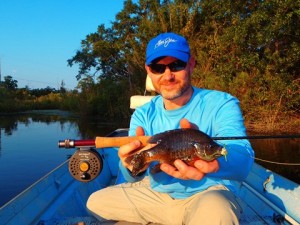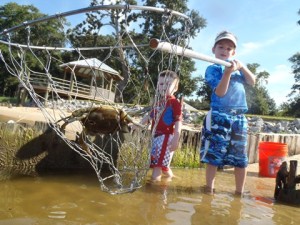
I’m told altitude sickness can do some strange things to the mind. A severe headache and disorientation to name a couple. Disorientation, otherwise known as a confused state of mind, can result in hallucinations.
I had a few days before having to conduct some business upon landing in Denver, Colorado and so with travel rod in tow, I made my way west up into the Front Range of the Rockies. I had read about some of the productive creeks in the foothills and had reserved a quaint stream-side cabin.
Upon checking in, the owner of the cabins gave me a few complimentary flies he tied. A nice touch, considering the effort and care that goes into tying flies. I’ve found that even if I think I’m prepared for a trip, including flies, I’m really not. Locals tie patterns that are specific for the water they fish, and I was thankful for not only the flies but also a very good fishing report.
Quickly unpacked, I strung up the fly rod with a #14 buckskin nymph, as recommended by the expert local knowledge acquired just a few minutes before. The stream’s flow was lively, dancing over and around rock formations. Towering pines canopied the stream’s width that spanned three or four lengths of a fly rod.
Spending the afternoon fly fishing to willing trout slips by quickly. Sometimes this happens before realizing the need for drinking fluids. Unfortunately, for a lowlander such as myself, fishing at altitude without hydrating can have negative consequences.
A headache set in and a nap was in order before an evening wade. A couple hours later I woke to not only a throbbing headache, but sick to my stomach. So, the only way I could think of to expunge the miserable feeling was to hit the river again. This time I packed a little water into an inside vest pocket.
Fly anglers have a sixth sense. We can hear a fish feed that only dimples the water from 200 feet away. Have you ever approached a stream’s bank, took a deep breath, raised your eyebrow, exhaled and exclaimed, “What a day this is going to be”? If you’re a fly angler, you know that sixth sense while on the water.
Casting upstream with a reach cast from left to right, my fly made a drift through a good seam. Upon picking up the fly at the end of the drift, I made a false cast and then something interrupted the process over my left shoulder. It was that feeling you get when you discover someone was watching you, even though you haven’t confirmed it. You just know somehow, something isn’t right.
Glancing over my left shoulder and across the stream, the hair on the back of my neck suddenly stood tall as two eyes and a pale face entered my periphery view. Before I could gain a clear picture of the life form in the trees, it disappeared. I have spent a lot of time in the woods, and never before had I seen anything like it, even considering my poor view. Initially, my thought was this might be a curious child climbing in the trees. Then again, the situation just didn’t add up.
Using a method I learned years before while deer hunting, I continued on with what I was doing so not to spook whatever it was. I remained aware out of the corner of my eye only, and didn’t allow myself to be focused in the direction of the strange sight. Within minutes, I again caught view of the pale face with large eyes that seemed to look right through me. This time I flipped the line upstream as if to fish another drift, but then turned and focused on the image in the trees intently. My thought was, “A monkey in Colorado? Impossible.” I am not native to the Rocky Mountains, nor have I studied in detail the wildlife that reside in the high hills of the Front Range, but this couldn’t be. But it was.
Over the next ten minutes or so, I watched the funny monkey jump from tree to tree, as if to gather information on me from different angles. Eventually, the monkey scurried away on a long branch, and I never saw him again.
That night as I turned in for bed with flu like symptoms, a debate waged in my mind as to whether I would tell anyone of the experience. Would anyone believe me if I told them anyway? How loco would locals think I was if I were to tell a story of a monkey peaking through pine branch needles as I fished below.
Curiosity got the best of me. The next day I ran into the owner of the cabins. Stumbling over my words a bit, I finally got the story out. He nodded his head and responded, “Rocky Mountain Tree Monkey.” There was silence between us, and I likely gave him the look of a very confused individual. But he didn’t waver. He convincingly told me of the occasional sighting of Rocky Mountain Tree Monkeys, although not commonplace.
I walked away from the conversation half feeling sheepish for telling the story, but half believing I was lucky to have witnessed such a rare event in the wilds of a Colorado mountain stream. Either way, I say long live the Rocky Mountain Tree Monkey. After all, I saw one don’t you know.
Copyright 2013 by icastinayak.com. All rights reserved
 Angler: Landon Rubel, with Chuck Fisk
Angler: Landon Rubel, with Chuck Fisk Chuck Fisk, Gulf Coast Council Conservation Director of the International Fly Fishing Federation,
Chuck Fisk, Gulf Coast Council Conservation Director of the International Fly Fishing Federation, Angler: IFA Kayak Fishing Tour Champion, Benton Parrott, with a nice Mobile Bay area redfish
Angler: IFA Kayak Fishing Tour Champion, Benton Parrott, with a nice Mobile Bay area redfish A Mobile Bay area marsh redfish on the fly
A Mobile Bay area marsh redfish on the fly




















